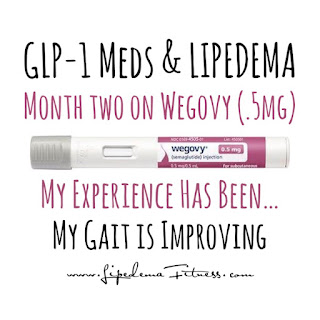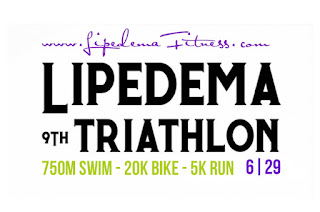June 29 is the 9th Annual Lipedema Triathlon
Pattie Cornute, Founder of Lipedema Fitness, started this event when she couldn't find a Lipedema 5K to participate in. Inspired by the LE&RN virtual 5K for Lymphedema she participated in, Pattie decided to create a virtual Lipedema 5K, when she could not find one to participate in.
Pattie wanted to incorporate the pool into the event, because many in the community use it to stay active (the pool is easier on their bodies, and the water has a natural gradient compression effect), and the 5K quickly turned into a Triathlon with the help of her coach, and one of her training mates, who was an Ironman with lots of experience.
The local YMCA in Pattie's town agreed to host her and her training mates, and has continued to host them every year, with the exception of the pandemic, when the gym was closed.
It is a Worldwide Virtual Event

From the very beginning, Pattie wanted this event to be open to everyone, no matter their physical abilities. As someone with late stage Lipedema, she knew the challenges that some of the community faced, she began calling it an All Or Something event - which means you can do all of the event, or some part of it, whatever that looks like to you.
Another way to open it up to as many people as possible, was to make it a virtual event - so you participate from wherever you live. You can talk to your local gym, in your neighborhood, or do it in your own home. Since the beginning we have had participants from all over the world taking part in this event. From places like Australia, England, Scotland, the Isle of Man, and this year we even have someone from Africa and Japan!
The first part of this event is a 750M swim...
The reason the swim is first leg of a triathlon is due to safety. You would think it would be easier (more convenient) to have the swim last, especially if you wear as much compression as those with Lipedema do, but trust me, you become tired doing 3 back to back portions of this event, and the last place you want an injury or to cramp up, is in the water.
🏊♀️ How many laps is a 750M swim if swimming in a pool?
That depends on the size of your pool - In the pool at my local YMCA (which is a short course Olympic pool) I need to do 30 length of the pool.
🏊♀️ How long does it take to complete the swim?
That depends on the swimmer. For me it is around 30 minutes. The kicker is I have to then shower off the chemicals, dry off really well, so I can get into fresh compression, and get all my workout gear on - this takes me longer than the swim itself, and counts in my overall time - if I was being official.
The second part of this event is the Bike…
Safety is also the reason the Bike comes second in a Triathlon. Outside of potential injuries, traditional outside racers would be a nightmare to have all starting/ending at the same time (for tracking purposes). Most of our local participants use stationary bikes, but we do have some that take off for outside rides. Coach plotted a course right from the YMCA.
🚴🏻♀️ How many miles is a 20K? It is 12.4 miles.
🚴🏻♀️ How long does it take to complete the bike?
That depends on the cyclist. For me it is around an hour. I started bringing my iPad to the event and use the Peloton app, picking (2) 30 minute rides seems the best for me. I love the artist series for motivation and been reviewing all our Friday Night rides to find my favorites. Two separate rides also gives me a chance to hop off the bike and stretch a bit, staying in the same position for too long can be extra challenging with Lipedema.
The third & final part is the Run/Walk…
The reason the Run/Walk is last in a triathlon is because it is the safest movement.
👟
How many miles is a 5K? It is 3.1 miles.
👟 How long does it take to complete the run/walk?
Again that depends on the participant. For me it used to be close to an hour, but as I transitioned through menopause that grew longer and more challenging, until last year I moved my 5K into the pool and used the aqua walking lane for my walk! It was fantastic, and since the water acts like compression, it really helped ease my legs and recovery was so much better.
How Can You Modify It? Short Answer, Anyway You Like!
Some participants get friends and family to help with the number of laps/miles, or they take multiple days to build up to the full distances. Some choose to do one leg of the event, just the swim, just the bike or just the run/walk.
Some other MODs (modifications) we have used over the years are:
- A rowing machine, or stand up erg, for the swim
- Peloton or stationary bike, or a Cubii (under desk elliptical) in place of riding a bike outside
- Mowing the lawn, or an underwater treadmill (someone did that last year), for the run/walk
All modifications count, we are an #allorsomething event!
We created this event to help spread Awareness for Lipedema &
the Importance of Staying Active with the condition.
Signup for the 2024 event HERE. You can sign up for any part of the triathlon you would like to, you can sign up a team to each take on a portion, or combine your efforts in any way that works for you. The goal is spreading awareness and having fun with the #lipedemacommunity
THANK YOU TO OUR SPONSORS & PRINTER:
Juzo Compression and Brenda Viola of Vici Communications
Thank you to Jewel from Crafted with TLC, LLC - a Lipedema patient owned business
You can purchase event merch to help spread awareness!
#lipedema #lipoedema #lipolymphedema #lipedemafitness #lipedemaawareness
























